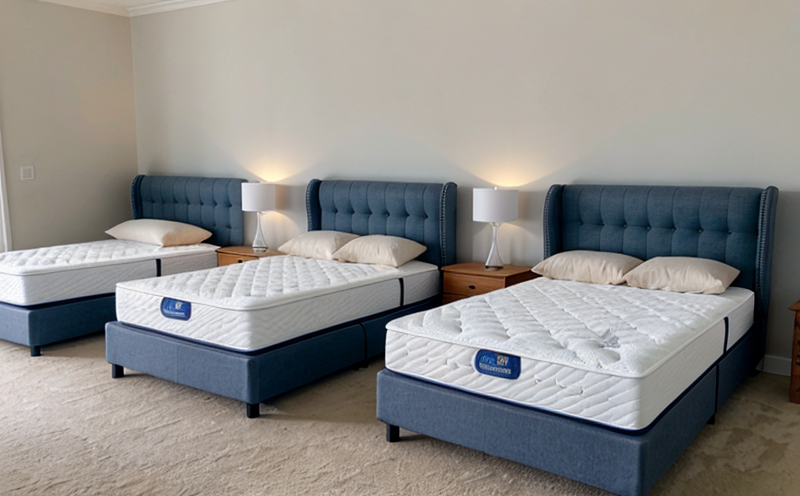ANSI UL 962 Household and Commercial Furnishings Electrical Safety of Adjustable Beds Testing
The ANSI/UL (Underwriters Laboratories) Standard 962 specifies safety requirements for adjustable beds, focusing on ensuring the electrical components do not pose a hazard to users. This standard is critical for manufacturers looking to ensure compliance with international safety regulations and protect end-users from potential risks.
Adjustable beds are designed to provide comfort and support by allowing users to adjust their sleeping positions. However, these beds incorporate complex electrical systems that must be thoroughly tested to guarantee they do not present a fire hazard or expose users to electric shock. The ANSI/UL 962 standard provides comprehensive guidelines for the design, manufacture, and testing of adjustable beds.
The standard covers various aspects of safety including:
- Electrical insulation integrity
- Grounding continuity
- Overcurrent protection
- Cord safety
- Control system reliability
The testing process involves a series of rigorous inspections and performance tests to ensure that the adjustable bed meets all specified requirements. This ensures not only compliance with regulatory standards but also enhances product quality and user safety.
Maintaining high standards in electrical safety is crucial for both manufacturers and users, as it helps prevent accidents and injuries. By adhering to ANSI/UL 962, companies demonstrate their commitment to producing safe products that meet the highest industry benchmarks.
Customer Impact and Satisfaction
Compliance with ANSI/UL 962 has a direct impact on customer satisfaction by ensuring that adjustable beds are safe for use in both residential and commercial settings. When users know their beds comply with rigorous safety standards, they feel more confident in the product's reliability and longevity.
Maintaining compliance also helps manufacturers avoid costly recalls and legal issues. This allows businesses to focus on innovation and customer service rather than dealing with potential hazards or negative publicity. For quality managers and procurement teams, ensuring that products meet these stringent standards can streamline supply chain management and reduce risks associated with non-compliance.
From a broader perspective, adherence to ANSI/UL 962 contributes to overall market confidence in the furniture industry. By setting high safety standards, companies like ours help build trust among consumers who value their health and well-being above all else.
Competitive Advantage and Market Impact
The implementation of ANSI/UL 962 provides significant competitive advantages in the marketplace by differentiating products based on safety features. Products that comply with this standard are more likely to gain market share due to increased consumer trust and preference for safer options.
- Enhanced brand reputation: Compliance signals quality assurance, which boosts customer confidence.
- Increased sales opportunities: Safe products open doors to new markets where safety is a priority.
- Premature obsolescence prevention: Ensuring long-term product performance and reliability.
In addition, compliance with ANSI/UL 962 aligns your offerings with global best practices. As standards evolve, staying ahead ensures that your products remain current and meet future demands without needing costly redesigns or recalls.
By prioritizing safety through rigorous testing according to ANSI/UL 962, you not only protect your customers but also safeguard the long-term success of your business. This proactive approach positions your company as a leader in innovation and commitment to excellence within the furniture sector.
Use Cases and Application Examples
The ANSI/UL 962 standard is particularly relevant for manufacturers producing adjustable beds designed for home use or commercial settings such as hotels, hospitals, and retirement communities. These environments require high levels of safety to accommodate a wide range of users.
In a typical testing scenario, the laboratory would receive samples from various brands of adjustable beds. The first step involves visual inspection to check for visible defects in wiring or connections that could indicate potential hazards. Subsequent steps include:
- Electrical insulation resistance measurement
- Cord and plug integrity checks
- Ground fault circuit interrupter testing
- Overcurrent protection verification
- In-use safety testing under specified conditions
The results of these tests are meticulously recorded, providing detailed reports that detail any discrepancies found during the evaluation process. These findings help guide necessary adjustments or improvements to ensure full compliance with ANSI/UL 962.
Real-world application examples include:
- A manufacturer improving their product lines based on feedback from our testing results.
- An adjustable bed designed for elderly care facilities receiving certification after meeting all specified criteria.
Through these processes, we contribute to enhancing the overall safety and reliability of adjustable beds across various industries.





